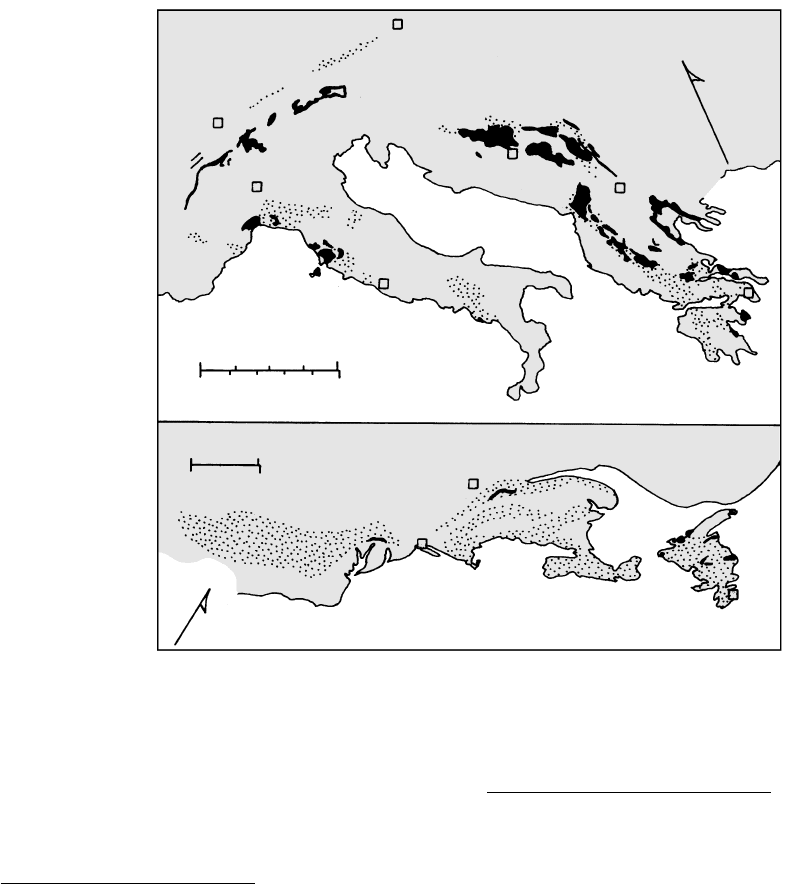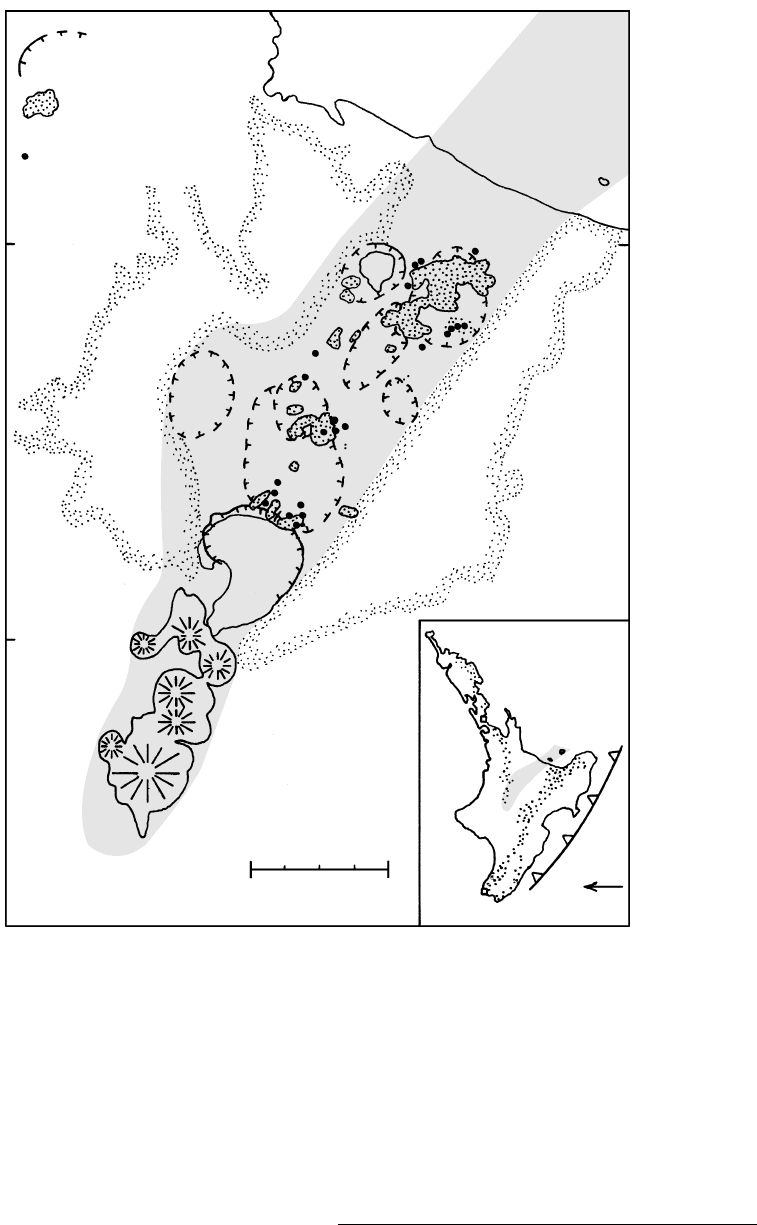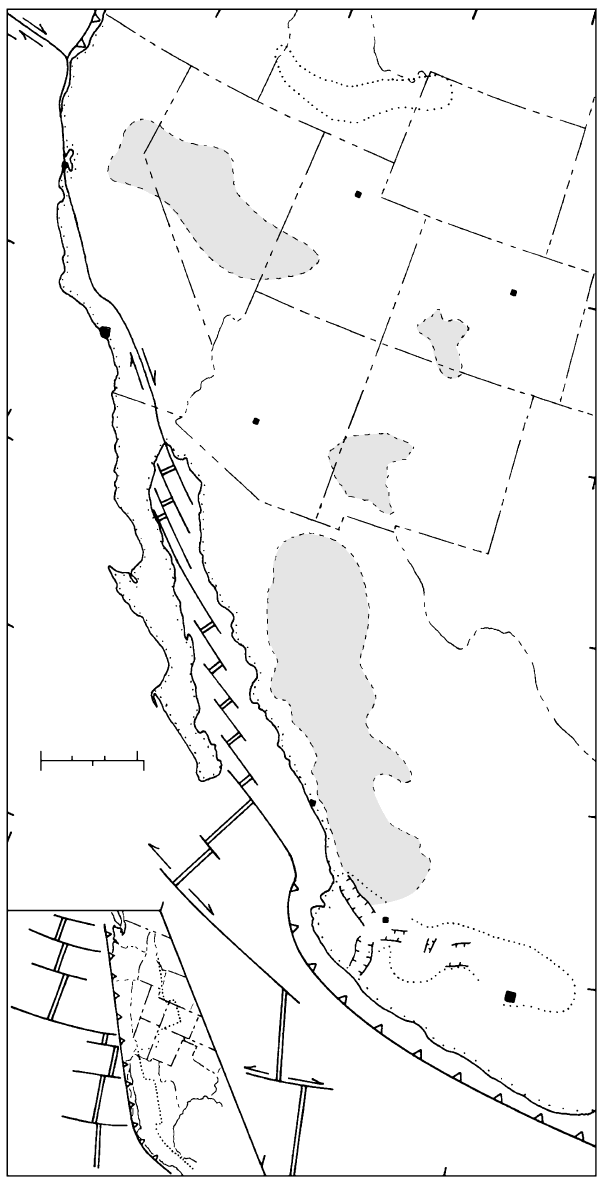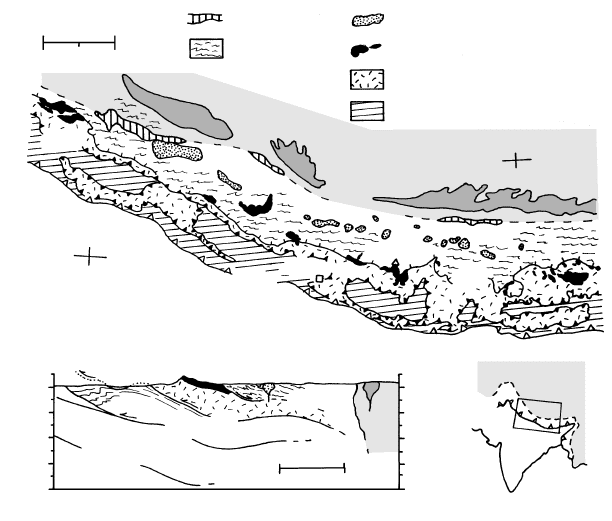Myron G. Best. Igneous and metamorphic 2003 Blackwell Science
Подождите немного. Документ загружается.


cumulates, locally in sharp contact with them, is
variably depleted in basaltic components. The de-
formed peridotite ranges from lherzolite to
harzburgite to dunite with increasing degrees of de-
pletion. This component of ophiolite is generally
the most prominent, in some locales cropping out
over thousands of square kilometers. Because of
their occurrence in orogenic belts, such as the Alps
(Figures 13.26 and 18.24), they have been referred
to as alpine peridotite. They are variably hydrated,
or serpentinized, form serpentinite rock, and show
effects of pervasive, grain-scale deformation.
13.6.2 Origin and Emplacement
The initial formation of ophiolite in an oceanic exten-
sional environment is unquestioned. But, in what
kind—ocean ridge, spreading back-arc basin, or possi-
bly an early extensional episode in island arc evolution?
The overwhelming extent of ocean ridges worldwide
no doubt led to the early opinion in the 1960s that they
were the environment from which ophiolites formed.
However, in the mid-1970s A. Miyashiro noted that
some rocks in the classic Troodos ophiolite have arclike
chemical affinities rather than normal MORB charac-
ter. Criticism was immediately raised that the wide-
spread and locally intense metamorphism likely invali-
dated any conclusions based on chemical composition
of the rocks. Nonetheless, fresh volcanic glass subse-
quently found in the Troodos has arc attributes, and
rocks from other ophiolites have also been found to
have typical arc signatures in relatively immobile ele-
ments Th, Nb, Ta, and REEs.
A dwindling proportion of ophiolites, if any, ap-
pears to be of ocean ridge origin. This has significant
implications for reconstructions of continental evolu-
tion by accretion of oceanic terranes.
The second basic question regarding ophiolites is
how variably dismembered slices of dense oceanic
lithosphere are accreted (tectonically emplaced) onto
margins of less dense continents and onto island arcs in
subduction zones, rather than being subducted. In one
possible model, oceanic mantle lithosphere overlying
subducting slabs is more buoyant because of wide-
spread serpentinization from released water, compared
to dry ocean-ridge mantle. (Density of olivine Fo
90
is
3.3 g/cm
3
versus serpentine 2.6 g/cm
3
.) Testifying to
the buoyancy of hydrated ultramafic rock are serpenti-
nite diapirs that have breached the ocean floor to cre-
ate seamounts in the Mariana forearc (O’Hanley, 1996,
p. 229). If ophiolites are emplaced within several mil-
lion years of their creation, as some chronologic data
seem to indicate, then the still relatively hot young
oceanic lithosphere would have additional buoyancy.
Lithosphere made buoyant by its youth and serpen-
tinization may allow nearby converging continental
margins of approximately similar, or slightly greater,
density (about 2.7 g/cm
3
) to be underthrust. Cool,
nonhydrated, ocean-ridge lithosphere may only be very
locally scraped off, if at all. (See Sections 18.5 and 18.6.)
13.7 CALC-ALKALINE CONTINENTAL
MARGIN MAGMATIC ARCS
During much of the Mesozoic and Cenozoic, the west-
ern coasts of the American continents were sites of arc
magmatism as oceanic lithosphere subducted beneath
them. Arc magmatism is also found on smaller conti-
nents, such as New Zealand and Japan, and islands in
the Caribbean and Mediterranean.
The same rock types (basalt to rhyolite) and rock
suites (low-, medium-, and high-K and shoshonitic) can
be found in both island and continental arcs. How-
ever, in continental arcs there is a greater proportion
of silicic calc-alkaline rocks—dacite, rhyolite (Figure
12.26b), and their plutonic granodiorite and granite
counterparts. Quartz and alkali feldspar are wide-
spread in silicic continental rocks but rare in island arc
rocks. Vast sheets of silicic ignimbrite and huge com-
posite granitic batholiths are unique to continents.
Concentrations of large-ion lithophile elements, in-
cluding K, Rb, Ba, Th, and U, are greater in conti-
nental rocks at a given silica content. In addition,
they generally have higher
87
Sr/
86
Sr and lower
143
Nd/
144
Nd ratios (Figure 12.31). These compositional con-
trasts are basically a result of the thicker and more
sialic crust in continental arcs into which primitive
mantle-derived magmas are intruded and experience
differentiation.
Magmatic Petrotectonic Associations
377
Table 13.7. Composition of Plagiogranite from the
Bay of Islands Ophiolite, Newfoundland
SiO
2
76.99 Co 4.4
TiO
2
0.13 Cr 43
Al
2
O
3
13.07 Ni 16
Fe
2
O
3
1.12t Sc 2.06
MnO 0.01 Ba 92
MgO 0.39 Th 4.67
CaO 1.99 Ta 0.90
Na
2
O 5.53 La 21
K
2
O 0.12 Ce 47.3
P
2
O
5
0.00 Sr 82
Total 99.35 Sm 6.79
Zr 182
Hf 7.43
Eu 1.12
Tb 1.24
Y62
Yb 6.89
Lu 1.04
Data from Elthon (1991).

378 Igneous and Metamorphic Petrology
km
miles
0 400
0 250
km
miles
0 400
0 250
N
New
York
City
Atlantic Ocean
St.
John's
New-
foundland
MOUNTAINS
APPALACHIAN
Montreal
Mediterranean
Rome
Sea
Sarajevo
Skopje
HELLENIDES
Athens
N
DINARDES
Vienna
Zurich
Milan
ALPS
13.26 Ophiolite in the northern Mediterranean and Appalachian regions. Ophiolite shown in black and areas containing ophiolite or deep
oceanic sedimentary rock are stippled. (Redrawn from Moores, 1982.)
13.7.1 Volcanic Arcs on Continental Margins
Four areas in the circum-Pacific provide a glimpse of
the nature and the variety of continental volcanic arcs.
North Island of New Zealand. This continental seg-
ment of the Tonga–Kermadec–New Zealand arc in
the southwest Pacific Ocean was previously cited in
Section 12.5.1 to demonstrate the contrast between
oceanic island and continental arc associations. Most of
the volcanic rocks in the Taupo volcanic zone of the
North Island of New Zealand (Figure 13.27) are calc-
alkaline andesite and rhyolite; basalt and dacite are
rare. The volcanic zone is a complex volcano-tectonic
depression created by crustal extension and filled with
as much as 3 km of volcanic rock. Eruption of poly-
genetic andesite magmas since about 2 Ma continues
today at composite volcanoes north and south of the
central rhyolite ignimbrite field. This is the most fre-
quently active and productive Quaternary rhyolite field
on Earth, where an estimated 16,000 km
3
of rhyolite
magma has been explosively erupted in the past 1.6 My
in 34 caldera-forming ignimbrite eruptions whose vol-
umes range from 30 to 300 km
3
(Graham et al.,
1995).
Andes of Western South America. This is the classic
example of continental arc magmatism, consisting of
thousands of Mesozoic-Cenozoic volcanoes as well as
local deeply eroded plutonic roots. The overall rela-
tively shallow dip (30°) of the subducting oceanic
lithosphere along the arc is attributed to its relatively
rapid rate of convergence, 10 cm/y, and youthful
buoyancy. Numerous contrasts along the arc are sig-
nificant (Figure 13.28). Active Quaternary volcanoes
are concentrated in three segments—northern, central,
and southern—of differing crustal thickness, age, and
composition that lie above lithosphere subducting
at angles of 20°–30°. Between these three segments,
along-arc flexures in the subducting slab allow dips
of only 5°–10°. These nearly horizontally subducting
slabs appear to be buoyed up by thick aseismic ocean
ridges, causing uplift of the overlying crust and ero-
sional unroofing of older plutonic rocks. Because there
is little or no subarc mantle wedge that could otherwise
generate magma, no active volcanism occurs.
Virtually the whole spectrum of volcanic edifices
(Chapter 10) are developed along the Andean arc, but
andesitic composite volcanoes dominate. Single vol-
canic debris avalanches cover as much as 100 km
2
.

Magmatic Petrotectonic Associations
379
However, in the central volcanic zone, where the crust
is oldest (includes Precambrian metamorphic rocks)
and thickest (as much as 70 km), late Cenozoic rocks
are predominantly silicic ignimbrites exposed over an
area of about 5 10
5
km
2
. The topographically high
central Andes, which include the Altiplano-Puna
(somewhat smaller than the Tibetan plateau in central
Asia), is exceptionally arid, barren, and unpopulated.
Consequently, very little is known of this remote cen-
tral region, other than from a few reconnaisance stud-
ies (see de Silva and Francis, 1991). Huge resurgent
calderas, as much as 35 60 km, are related to volu-
minous (1000 km
3
) dacite ash-flow eruptions appar-
ently spawned by crustal thickening and mafic magma
underplating since the late Miocene.
Southwestern North America Ignimbrite Pr
ovinces.
A
remarkable facet of Cenozoic volcanism in southwest-
ern North America was an ignimbrite flareup during
the Oligocene (Best et al., 1989). In 10 My, at least
10
5
km
3
of ignimbrite blanketed parts of Nevada,
Utah, Colorado, Arizona, New Mexico, and Mexico
White Is.
Indian
plate
Auck-
land
Well-
ington
0
km
40
25
0
miles
TAUPO
VOLCANIC
1.6 −
0.9
ignimbrite
<0.3
<0.3
Whale
Island
ZONE
Bay of
Plenty
Silicic dome
38°S
39°S
Rhyolite
<0.9
<0.2
<0.2
<0.3
<0.3
Lake
Taupo
Rhyolite ignimbrite
Pacific plate
4
mm/y
Basalt
Caldera
Composite
andesite volcanoes
13.27 Taupo volcanic zone (shaded) on the North Island of New Zealand. See also Figure 12.26a. White and Whale Islands are active andesite
composite volcanoes in the Bay of Plenty northeast of the caldera-ignimbrite field. Exposed metamorphosed sedimentary rocks are stip-
pled on small-scale map lower right. Time of caldera-forming eruptions indicated in millions of years (e.g., 0.3, 1.6–0.9). (Redrawn from
Graham et al., 1995.)

380 Igneous and Metamorphic Petrology
(Figures 13.29 and 13.30). Although most of the hun-
dreds of caldera-forming ash-flow eruptions that cre-
ated this ignimbrite blanket were of rhyolite magma
derived from compositionally zoned crustal chambers,
the very largest were of crystal-rich dacite magma. Af-
ter disgorging thousands of cubic kilometers of dacite
ejecta to depths of as much as 500 m, huge, 50–70 km-
diameter calderas formed above probably slablike
chambers as similar volumes of ejecta continued to be
erupted into the subsiding depression.
It may be surprising that subduction-related ig-
nimbrites having typical arc trace element signatures
occur so far inland from the North American plate
margin, as far as southwestern Colorado. However,
east-west crustal extension since the ignimbrite flareup
has increased this distance by perhaps 200–300 km in
13.28 Western South America magmatic arc. Coastal Peruvian batholith (black) is Cretaceous next to coast and Cenozoic inland. Triangles,
Holocene (active) volcanoes. Heavy dashed line, position of 150 km-depth contour on top of Wadati-Benioff seismic zone showing two
segments of arc where slab subducts only 5–10°, precluding active volcanism. Shaded, area of average elevation 3 km and to as much
as about 7 km, including Altiplano in Bolivia and southern Peru and Puna in northern Chile and Argentina. The notes along the right
side contrast the three active volcanic arc segments. S, shoshonitic volcanic centers. (Redrawn from Wilson, 1989; Jordan et al., 1983.)
0 800
km
0 500
miles
40° S
30°
20°
10° S
10° N
Ecuador
90° W
70° W
Juan Fernandez
Ridge
∼ 10 cm/y
Nazca Ridge
Trench
Bolivia
150 km
S
Argentina
Peru
Columbia
90° W
Batholith
S
S
Chile
50° S
Volcanic zone
Crustal thickness (km)
Age of crust
Dominant
volcanic rocks
Southern
30−35
Meso-Cenozoic
Basalt ± andesite
Central
50−70
Precambrian-Paleozoic
Andesite + dacite +
Northern
40
Late Meso-Cenozoic
Andesite
S
1.4−2.2
6.3−7.7
0.7036−0.7046
K
2
O (wt.%)
δ
18
O
87
Sr/
86
Sr
0.4−2.8
5.2−6.8
0.7037−0.7044
± dacite
rhyolite
1.4−5.4
6.8−14.0
0.7054−0.7149

13.29 Some major Cenozoic volcanic provinces in the southwestern part of the North America plate and current plate boundaries. Cenozoic
volcanic fields to the north of this map are shown in Figure 13.31. Plate configuration at 30 Ma in small-scale inset lower left shows that
a subduction zone extended continuously along the western margin of North America, and the eastern edge of the “viable” subducting
slab (approximately located by dotted line) extended far inland. (Redrawn from Severinghaus and Atwater, 1990.) In most of California
this convergent plate boundary has now been replaced by the San Andreas transform fault. Shaded areas are major ignimbrite fields em-
placed during the middle Tertiary. Hundreds of source calderas in these ash-flow fields are not shown. Extent of the Sierra Madre Occi-
dental ignimbrite plateau in Mexico (Figure 13.30) is highly generalized because so little is known of this region. A thin veneer of basalt
flows erupted 17 Ma in the Snake River Plain covers thick rhyolite lava and ash flows that emerge from beneath the veneer at currently
active Yellowstone (Y) (Hildreth et al., 1991). Rhyolite calderas monotonically decrease in age to the northeast, possibly because of the
southwestward passage of the continental plate over a mantle plume, the head of which may have created the Columbia River Plateau
off the northwest corner of this map (Figure 13.31). Late Cenozoic normal faults (lines ornamented with ticks) have formed rift grabens
in the western part of the Mexican Volcanic Belt.
0 miles 200
0 km 300
115°
20° Ν
25°
30°
120°
Los
Angeles
San
Fran-
cisco
PACIFIC
PLATE
San Andreas
Fault
Sierra Nevada
Batholith
Basin
Range
Phoenix
Arizona
Nevada
California
120° 110° W
Snake
R.
Plain
Idaho
Utah
Y
Wyoming
Salt Lake
City
Colorado
Denver
San
Juan
New
Mexico
Mogollon
Datil
Texas
35°
110°
Mazatlan
Guadalajara
Mexican volcanic belt
Mexico
City
COCOS PLATE
100° W
Sierra
Madre Occidental
RIVERA
PLATE
25° Ν
MEXICO
and
Northern

382 Igneous and Metamorphic Petrology
places. Also, plate reconstructions for the Tertiary of
western North America disclose a rapidly converging,
northeastward-moving, low-dip oceanic lithosphere
that advanced far inland (Figure 13.29, inset). This
low-dip slab is reminiscent of the post-late Miocene
character of the central Andes. Indeed, the composi-
tions of Oligocene volcanic rocks in the northern Basin
and Range province are most like those of the central
Andes of any continental arcs and suggest that this
Oligocene ignimbrite province was a high plateau un-
derlain by crust thickened during Mesozoic compres-
sional orogeny and probably by middle Tertiary mafic
underplating.
Cascade Range. The linear arc of composite Qua-
ternary volcanoes from southern British Columbia
through Washington and Oregon and into northern
California (Figure 13.31) is one of the better known ac-
tive volcanic arcs in the world. Included in the arc are,
from north to south, the recently active Mount Saint
Helens (Figures 10.1 and 10.20), Crater Lake and an-
cestral Mount Mazama (Figure 10.38), Mount Shasta
(Figure 10.2), and Lassen Peak (Figure 10.18). Several
attributes of the Cascades should dispel any notions
that this arc is like all others and that all continental
margin volcanic arcs are the same.
The subducting Juan de Fuca oceanic plate beneath
the arc is relatively thin and warm because the ocean
spreading ridge is near the trench. Volumetrically mi-
nor composite Quaternary volcanoes have been built
within the past 1 My on a platform of older basaltic and
andesitic rocks produced by more diffuse and inter-
mittent volcanism during the Cenozoic. Deep erosion
has exposed the plutonic roots of some of these magma
systems (Figure 9.5).
While focused magma systems were creating
andesite-dacite composite volcanoes, numerous sur-
rounding vents were erupting mainly basaltic lavas,
forming monogenetic cinder cones, lava flows, and
shields. Many of these basaltic lavas in southern Wash-
ington (Leeman et al., 1990) are primitive, ranging
from calc-alkaline through tholeiitic to alkaline. Signif-
icantly, only a few have typical arc signatures. Instead,
most have trace element and isotopic compositions of
oceanic island basalts, a feature noted in some rocks of
other arcs. In the Cascades, the subducting young and
still warm Juan de Fuca slab may have been virtually
dehydrated before reaching conditions at which typical
arc magmas could be generated in the subarc mantle
wedge. Mount Saint Helens, for example, has erupted
adakite magmas generated in the basaltic subducted
slab. This postulated “dry” wedge, together with con-
tamination by accreted Mesozoic and early Cenozoic
oceanic and island-arc lithosphere, may explain the di-
verse and primitive basalt magma compositions. Qua-
ternary composite volcanoes at the northern and par-
ticularly the southern end of the Cascades have a
tendency to erupt magma of more silicic composition.
This may reflect their construction on older continen-
tal crust, as opposed to the more oceanic character of
the young mafic crust beneath the central Cascades.
13.7.2 Plutonic Arcs on Continental Margins:
Granitic Batholiths
Felsic plutonic and volcanic rock-forming systems were
once considered to be genetically separate. However,
many observations and arguments clearly indicate that
volcanoes have plutonic roots; however, the opposite is
not necessarily true because not all intrusive magma
vents to the surface. The volcanic-plutonic connection
follows from the reasonable inference that erupting
magma chambers do not completely empty themselves
and is confirmed by the continuities in exposure between
volcanic and plutonic bodies at some locales (e.g., Figure
9.5; also Figure 13.36). Along strike of the Cascade vol-
canic arc (Figure 13.31) and the Andean volcanic arc
(Figure 13.28) locally deep erosion has stripped off the
volcanic cover, exposing plutons of much the same age
and compositions as the volcanic rocks.
Batholiths (Section 9.4.2) made predominantly of
tonalite and granodiorite, but ranging from granite to
gabbro, are a typical feature of every orogenic belt as-
sociated with subduction of oceanic lithosphere be-
neath a continental margin. In the western North
American Cordilleran orogen (Figure 9.16), these
mostly Mesozoic batholiths include the Coast Range,
Idaho, Sierra Nevada, and Southern California–Penin-
sular Ranges. Additional Mesozoic-Cenozoic bath-
oliths occur along the west coasts of Central and South
America (Kay and Rapela, 1990).
Sierra Nevada Batholith, California. As no two batho-
liths are exactly the same, any description of one omits
13.30 Panoramic view of the Sierra Madre Occidental ignimbrite
plateau east of Mazatlan, Mexico. The entire rock sequence is
rhyolitic ignimbrite; individual layers are as much as hundreds
of meters thick. (Photograph courtesy of Gary J. Axen.)

Magmatic Petrotectonic Associations
383
features of others. However, because the central one-
fourth of the Sierra Nevada Batholith (Bateman, 1992)
is well-documented, it will be used as an example. Em-
placement of the approximately 120 separate mapped
plutons began in the late Triassic at about 210 Ma and
continued episodically into the late Cretaceous until
about 85 Ma (Figure 13.32). For uncertain reason,
much of the topographic uplift of this mountain range
did not occur until the late Cenozoic. Pluton host rocks
are strongly deformed and mildly metamorphosed
Paleozoic-Mesozoic volcanic and sedimentary rocks; in
the west they include accreted oceanic terranes.
Most plutons in the Sierra are tonalite, granodiorite,
and granite (Figures 2.6 and 12.30). Among mafic
minerals, biotite and Fe-Ti oxides are ubiquitous;
hornblende and titanite (sphene) are common. Many
plutons are composite or zoned in fabric and/or com-
position and constitute comagmatic suites. Zones can
be gradational from one to another or in sharp contact
with one another, implying some cooling before the
next intrusion of magma. The Tuolumne Intrusive Se-
ries (Figure 9.18; Table 13.8) is a classic example of a
concentrically zoned pluton that has zones of younger
and progressively more felsic rock that crystallized at
lower T inward from the pluton margin. This comag-
matic sequence, which appears to have been emplaced
within a few million years near 87 Ma, spans the en-
tire spectrum of rock types constituting the whole
batholith, with the exception of the most mafic rock
types; hence, understanding its origin can provide
insight into the evolution of the entire Mesozoic
batholith.
Competing models for zoned plutons include the
following:
1. Contamination of the outermost part of the magma
body with mafic wall rocks
2. Multiple intrusion
3. Convective melt fractionation driven by sidewall
crystallization (e.g., Bateman and Nokleberg, 1978;
Sawka et al., 1990; Bateman, 1992, pp. 67–82; see
also Section 12.2.1)
This model has received widespread acceptance as
the probable mechanism of differentiation of
13.31 Selected Cenozoic magmatic rocks of southern British Columbia, Washington, Oregon, Idaho, and northern California. Juan de Fuca
oceanic plate subducts beneath the continental margin. For clarity, names of most Quaternary composite volcanoes are placed off coast.
Hundreds of known exposed feeder dikes in Columbia River Plateau are schematic.
Mt.
Garibaldi
British Columbia
Washington Idaho
Mt.
Adams
Newberry
volcano
AMERICAN
Oregon
PLATE
miles
1000
1600
km
California
Mt. Shasta
Lassen Peak
40° N
Ocean
PACIFIC
PLATE
Mt. Jefferson
Mt. Hood
Mt. St. Helens
Mt. Rainier
Glacier Peak
Mt. Baker
Three Sisters
130° 120° W
45°
Columbia River flood
basalt plateau
Tertiary diorite and
granodiorite plutons
Quaternary composite
volcano
Quaternary andesite
and basalt
NORTH
Crater
Lake
JUAN DE FUCA
PLATE
Pacific

384 Igneous and Metamorphic Petrology
andesite-dacite-rhyolite magma chambers that erupt
well before total crystallization to produce composi-
tionally zoned pyroclastic deposits (Figure 9.38).
Crystallization of higher-T mafic minerals and pla-
gioclase along the cooled margin of the magma
chamber allows buoyant residual melts enriched in
water and more felsic components to escape, collect-
ing into the interior and eventually rising to the top
of the magma chamber. Because of limited vertical
exposure, few plutons can be examined to verify this
model (but see Cornejo and Mahood, 1997).
For the Tuolumne series, Kistler et al. (1986) find el-
emental and isotopic evidence that mantle-derived
basalt magmas stagnated in the lower crust, fraction-
ated, and mixed with variable amounts of more felsic
and radiogenic anatectic melts generated by their heat.
These magmas created by AFC were emplaced at the
present level of exposure in at least four surges (Figure
9.18), each more felsic than the preceding one. Once
emplaced, the magmas experienced limited convective
melt fractionation as hornblende and plagioclase crys-
tallized.
13.32 (a) Generalized geologic map across the central Sierra Nevada batholith. Shown are 18 outlined intrusive suites of multiple plutons of
similar character that are believed to have originated in a distinct magmatic episode. Note space-time relations, including the predomi-
nantly Cretaceous eastward-migrating magmatism that split the older Jurassic arc. More detailed map of the Tuolumne Intrusive Series
is shown in Figure 9.18. Late Cenozoic extensional faulting dropped valley-forming grabens, such as the one in which the town of Bishop
is located, separating the main part of the batholith on the west from an eastern segment. Blank areas within batholith were unmapped
(as of 1981). (Redrawn from Stern et al., 1981.) (b) Variation in modal percentages of alkali feldspar and
87
Sr/
86
Sr across the batholith
along the east-northeast trending line through Bishop shown in (a). Redrawn from Bateman (1992).
Tuolumne
Intrusive Series
120° W
119° W 118° W
Post-batholith
deposits
Country
rocks
Ultramafic
rocks
My ago
50
100
150
200
Cretaceous
Jurassic
Triassic
0
km
80
0
mi
50
37° N
38° N
Bishop
0.710
10
30
50
0.706
0.702
87
Sr/
86
Sr
West East
Modal % alkali
feldspar
(a)
(b)

Magmatic Petrotectonic Associations
385
A similar sort of interaction with the preexisting
crust, but on a larger scale, is manifested in a regu-
lar compositional variation across the Sierra Nevada
batholith (Figure 13.32). This pattern is mostly inde-
pendent of pluton age. Tonalite is the most common
rock type in the west, granodiorite along the batholith
axis, and granite in the east. Alkali feldspar increases
in modal proportion from about 4% in the west to
about 30% in the east. Whereas SiO
2
is fairly con-
stant, large-ion-lithophile elements (K, Rb, Ba, U, Th)
and light REEs increase eastward, as does
87
Sr/
86
Sr,
whereas
143
Nd/
144
Nd, CaO, MgO, and total Fe de-
crease. Tonalites on the west likely formed from
fractionated mantle-derived magmas, possibly contam-
inated only by young mafic crust. Progressively east-
ward, these primitive magmas were increasingly conta-
minated and mixed with partial melts of older felsic
continental crust.
Table 13.8. Compositions of Granitic Rocks from the Sierra Nevada Batholith
1 2345 6
SiO
2
(61.52) 58.59 65.61 67.83 69.76 71.65
TiO
2
(0.73) 0.90 0.54 0.49 0.37 0.24
Al
2
O
3
(16.48) 16.93 15.44 15.44 15.49 14.87
Fe
2
O
3
2.26 1.76 1.55 1.24 0.84
FeO 6.18t 4.31 2.38 1.44 0.95 0.81
MnO 0.11 0.11 0.80 0.06 0.05 0.04
MgO (2.80) 3.26 1.80 1.03 0.66 0.38
CaO (5.42) 6.25 4.10 3.22 2.52 1.87
Na
2
O 3.30 3.53 3.62 4.02 4.33 3.98
K
2
O 2.41 2.38 3.11 3.65 3.72 4.19
P
2
O
5
(0.25) 0.22 0.16 0.17 0.13 0.08
H
2
O
(1.04) 1.01 0.78 0.61 0.45 0.58
H
2
O
(0.2) 0.14 0.14 0.1 0.09 0.17
Total 100.44 99.89 99.52 99.61 99.76 99.70
Rb 79.8 108 138 129 137 158
Ba 715 720 515 905 740 1170
Th 6.37 16.6 21.8 18 18.4 16.8
U 2.89 4.2 7.4 5.2 8.8 3.8
Nb 8 7 7 8 9
Ta 1.27
La 30.2 21 23 25 29 26
Ce 53.9 47 38 44 49 49
Sr 452 574 451 658 621 484
Nd 21.7 18 11 13 21 15
Sm 6.12 4 2.5 3 3 2
Zr 241 126 116 119 126 138
Hf 5.23
Eu 1.52 1 0.7 0.9 0.8 0.6
Tb 0.98 0.7
Dy 3.41
Y189878
Ho 8 5.5 5 6.6 5.2
Yb 1.77 1.3 1.3 0.6 0.6 0.6
Lu 0.31 0.2 0.17 0.1 0.1 0.1
Cr 22.8 17 9 6 1 1
Ni 11 11 5 2 2 2
Sc 9.66 16 8 4 3 2
Columns 2–6 from the Tuolumne Intrusive Series represent the five intrusive stages of the zoned intrusion shown in Figure 9.18a–d. (From
Bateman and Chappell, 1979; Frey et al., 1978.)
1, Bass Lake Tonalite. Data from Dodge et al. (1982). Values in parentheses are average tonalite. From Le Maitre (1976). 2, Quartz diorite north
of May Lake. 3, Equigranular Half Dome Granodiorite. 4, Porphyritic Half Dome Granodiorite. 5, Cathedral Peak Granodiorite. 6, Johnson
Granite Porphyry.

386 Igneous and Metamorphic Petrology
A belt of widely scattered Mesozoic plutons extends
several hundred kilometers inland of the North Amer-
ica batholith arc (Miller and Barton, 1990). Magmas
producing these mostly Cretaceous plutons had an in-
creasing crustal component through time. In some ar-
eas, latest Cretaceous plutons are strongly peralumi-
nous two-mica granites that were probably derived
entirely by anatexis of ancient crust. Unlike the
S-type granites of eastern Australia, the North Ameri-
can peraluminous granites contain no cordierite.
Nonetheless, high
87
Sr/
86
Sr (to as much as 0.737) and
18
O (to 13%o), and low
143
Nd/
144
Nd (to 0.5118) in-
dicate significant amounts of magma from a metasedi-
mentary source. Many petrologists have hypothesized
that crustal anatexis was energized by internal heating
effects in the crust thickened by orogenic contraction
(Section 11.1.1). Even if the thickened crust did not
itself provide sufficient internal heat for anatexis, it
would promote more contamination of ascending mag-
mas because of the greater path length and residence
time of ascending more primitive magmas.
13.8 GRANITES IN CONTINENT-
CONTINENT COLLISION ZONES
Ancient examples of continent-continent collisions are
the Paleozoic Hercynian orogen in southern Europe
and the Proterozoic Grenville orogen in eastern
Canada. In more recent geologic time, since about
55 Ma, the Indian and Asian continental plates have
converged, forming the highest mountains on Earth—
the Himalaya. An estimated 1000–1500 km of crustal
shortening and doubling of crustal thickness to about
80 km have taken place in the collision zone that in-
cludes the Himalaya Mountains and the Tibetan
Plateau farther north in the Asian plate. A volcanic arc
formed before continent-continent collision but was
extinguished as subduction of oceanic crust stopped.
Consequently, no volcanic rocks are directly associated
with this collision. However, highly potassic mafic lavas
and local peraluminous rhyolites 13 Ma old occur in
the central Tibetan Plateau that may be related to local
extensional tectonism in the gravitationally unstable
high landmass.
Early Miocene (20 Ma) magmatism in the
Himalaya orogen is represented by generally sheet-
like granitic plutons and swarms of innumerable
smaller dikes, sills, and irregular intrusive bodies.
They form a chain of intrusions for about 2000 km
along the crest of the High Himalaya (Figure 13.33).
Unlike in other granite associations where a range
of rock types coexist, the Himalayan rocks are rela-
tively uniform S-type leucogranites composed of a per-
aluminous assemblage of quartz (about 31 modal %)
13.33 Generalized geologic map and cross section of the Himalaya Orogen. Note three belts of plutonic magmatic rocks: (1) The northernmost
is the Gangdese batholith (dark shade) emplaced from the late Cretaceous to Eocene and generated during subduction of the oceanic
Indian plate before continental collision. The North and High Himalayan granites were emplaced in thickened continental crust in the
early Miocene after continental collision. The suture between the Eurasian continent (light shade) and the northward-colliding Indian
continent is marked by lenticular slices of seafloor ophiolite scraped off the Indian oceanic lithosphere. The crustal thickening and north-
south shortening are produced by an imbricate stack of thick thrust sheets that moved along the Main Central Thrust (MCT) and Main
Boundary Thrust (MBT). SDT, Southern Tibetan Detachment, a low-angle normal fault that formed late in the topographically elevated
orogen. (Redrawn from France-Lanord and Le Fort, 1988.)
MCT
MBT
Gangdese
batholith
suture
90° E
30° N
Mt.
Everest
Eurasian
plate
Kathmandu
MCT
MBT
Moho?
80
60
40
20
0
South
North
28°N
80°E
400
0
25
km
miles
Sea level
Indian
plate
km
1600
km
0
100
miles
Ophiolite
Metamorphosed
sedimentary
rocks
North Himalayan granites
High Himalayan leuco-
granite
Gneiss, migmatite
Sedimentary rocks
STD
STD
Indian Ocean
